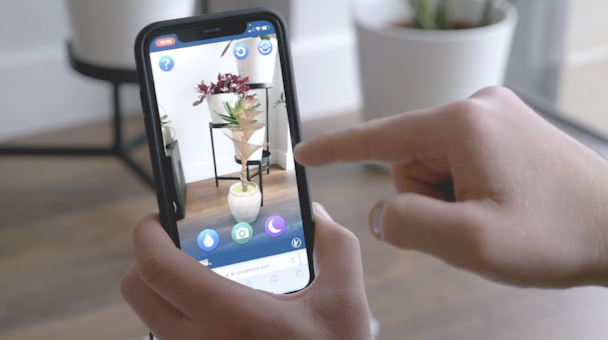3 UX considerations when designing for augmented reality
Crucial to any augmented reality (AR) experience is how the user feels after. Zappar's Caspar Thykier explains which type of AR experience is for you, and how to make it as easy to use as possible.

Social space experiences are best for visualizing products like furniture to scale. / Image courtesy of Zappar
At the heart of the success (or failure) of any new technology is the end user, and how carefully that new experience has considered them. Augmented reality (AR) is no different – brands need to put themselves in their desired user's shoes and not only think about what they are getting from the campaign, but crucially, the ease at which they can access it.
This is where user experience (UX) design can make or break your AR experience. No matter how impressive your technology is, if your audience doesn't like using it, you’re sunk.
Effective UX design places that valuable end user at the center while taking into account their real needs and helps to create a seamless delivery of information. For a technology like AR – which relies on UX design to blend software and hardware together in variable environments and locations – it’s never been more important.
Advertisement
1. Fit the AR experience to the environment
AR experiences are connected to the real world, meaning the environment will always play a key role in the design process.
There are four different types of space within UX: intimate, personal, social and public. Each of these will lend itself to different types of AR experiences.
Intimate space experiences involve a person’s face, head or hands, and lend themselves to anything face-tracked. Examples of this are, of course, the classic face filters, designed to promote social sharing or be utilized for virtual try-on, but also more creative uses such as informative ‘hot spots’ often used by skincare brands to highlight areas targeted by the product.
Advertisement
Personal space experiences can feature real objects, people, or the area around you. These are often providing users with information at the point they need it most, like on product packaging and can be anchored to the objects with image tracking or in the immediate space around them with world tracking.
Social space experiences need to allow the users to pan the camera further away, so other people and objects can occupy the area. Ideal for product visualization, so augmenting objects to scale like furniture, as well as augmented photo features and multiple face tracking for social sharing.
Public space experiences are usually anchored to specific locations with enough area to place an augmentation. Perfect for museums or attractions, these allow the most environmental control and are usually world tracked and can bring statues to life in theme parks (for example).
Suggested newsletters for you
2. Seamlessly guide the user through
With any new technology, how you guide your users through the experience is vital as it may well be the first time they have encountered the technology at all – let alone your experience.
With AR, the fewer instructions that are needed, the better. Part of the joy should be navigating and exploring. However, for some projects, it can be useful to include a brief onboarding including instructions on how to navigate the experience. Instructions like ‘point your phone at the image’, ‘tap this button’ or ‘place the model in your own space’ will provide all the information your user needs.
To help your users navigate the experience, you can highlight elements that can be tapped or clicked to move to the next scene.
A good place to start with this is using animations or effects like glowing buttons as well as using prompts to encourage people to tap or click. Making use of universal icons and assets that communicate instructions is ideal, especially when launching an experience within multiple language zones.
3. Consider accessibility
It’s important to note here that as a relatively new and visual technology, there are still a lot of unknowns when it comes to making AR completely accessible. But there are still certain factors when it comes to design – user interface (UI) as well as UX – that you need to test for, especially when it comes to users' sight.
Elements such as font and color contrast, as well as going further and considering layer sound cues on top of the experience.
Considers things like button size – this can support both the visually impaired but also those with mobility issues. Designing totally accessible AR whilst not losing a feature-rich experience and losing the interest of other users is a challenge, however, making these changes can help make your experiences more accessible.
Focussing on these considerations allows you to keep your user in mind and guides the development of good UX/UI experiences. It’s crucial to make sure you understand how and where the experiences work, what it's trying to solve or provide and how the user should feel afterward.
Content by The Drum Network member:

Zappar
Zappar is the world’s leading augmented reality platform and creative studio for mobile and web apps. Since 2011, Zappar’s mission has been to democratise AR...
Find out more
